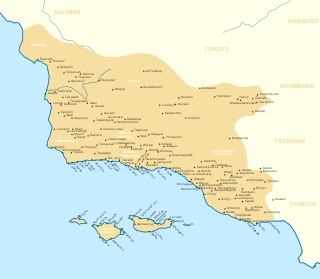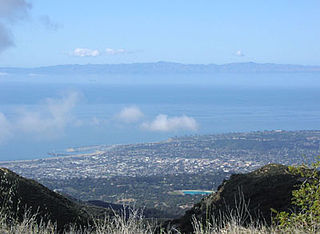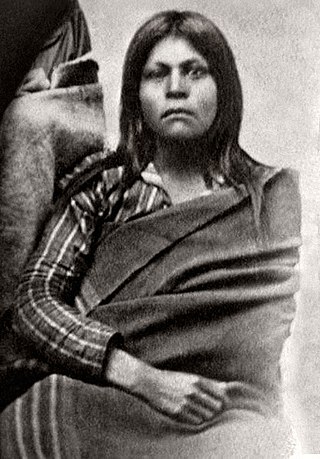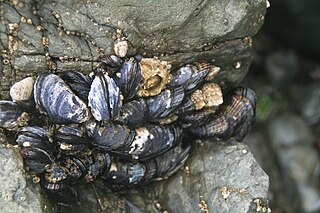Related Research Articles

A mammoth is any species of the extinct elephantid genus Mammuthus. The various species of mammoth were commonly equipped with long, curved tusks. They lived from the late Miocene epoch into the Holocene about 4,000 years ago, and various species existed in Africa, Europe, Asia, and North America. Mammoths are more closely related to living Asian elephants than African elephants.

The Chumash are a Native American people of the central and southern coastal regions of California, in portions of what is now Kern, San Luis Obispo, Santa Barbara, Ventura and Los Angeles counties, extending from Morro Bay in the north to Malibu in the south to Mt Pinos in the east. Their territory includes three of the Channel Islands: Santa Cruz, Santa Rosa, and San Miguel; the smaller island of Anacapa was likely inhabited seasonally due to the lack of a consistent water source.

The Channel Islands are an eight-island archipelago located within the Southern California Bight in the Pacific Ocean, off the coast of California. The four Northern Channel Islands are part of the Transverse Ranges geologic province, and the four Southern Channel Islands are part of the Peninsular Ranges province. Five of the islands are within the Channel Islands National Park, and the waters surrounding these islands make up Channel Islands National Marine Sanctuary. The Nature Conservancy was instrumental in establishing the Channel Islands National Marine Sanctuary.

Channel Islands National Park consists of five of the eight Channel Islands off the Pacific coast of the U.S. state of California. Although the islands are close to the shore of the densely populated state, they have been relatively undeveloped. The park covers 249,561 acres (100,994 ha), of which 79,019 acres (31,978 ha) are federal land.

San Miguel Island is the westernmost of California's Channel Islands, located across the Santa Barbara Channel in the Pacific Ocean, within Santa Barbara County, California. San Miguel is the sixth-largest of the eight Channel Islands at 9,325 acres (3,774 ha), including offshore islands and rocks. Prince Island, 700 m (2,300 ft) off the northeastern coast, measures 35 acres (14 ha) in area. The island, at its farthest extent, is 8 miles (13 km) long and 3.7 miles (6.0 km) wide.

The Channel Islands National Marine Sanctuary is a sanctuary off the coast of Santa Barbara and Ventura counties in Southern California 350 miles south of San Francisco and 95 miles north of Los Angeles. It was designated in 1980 by the National Oceanic and Atmospheric Administration.

Santa Rosae was, before the end of the last ice age, an ancient landmass off the coast of present-day southern California, near Santa Barbara County and Ventura County, of which the northern Channel Islands of California are remnants. At its largest, Santa Rosae was roughly 3-4 times bigger than the northern Channel Islands of today, nearly 125 km long from east to west. Between about 20,000 and 5,000 years ago, Santa Rosae lost about 70% of its land mass to post-glacial rising sea level, leaving behind a vast submerged landscape currently being explored by scientists. San Miguel, Santa Rosa, Santa Cruz, and Anacapa Island comprise the unsubmerged portions of Santa Rosae today. This island was about 5 miles offshore. It broke up between about 11,000 and 9,000 years ago, and the present northern Channel Islands took their shape after the continental ice sheets melted and sea levels rose by about 100 meters.
Arlington Springs Man was a Paleo-Indian whose remains were found in 1959 on Santa Rosa Island, one of the Channel Islands located off the coast of Southern California. He lived about 13,000 years BP, making him possibly the earliest dated person in North America, and an important scientific discovery that supports the coastal migration theory for the peopling of the Americas. In 2022, Arlington Springs Man was returned under the Native American Graves Protection and Repatriation Act (NAGPRA) to the Santa Ynez Band of the Chumash Indians for reburial according to native customs at an undisclosed location.

The Santa Barbara Channel is a portion of the Southern California Bight and separates the mainland of California from the northern Channel Islands. It is generally south of the city of Santa Barbara, and west of the Oxnard Plain in Ventura County.

Santa Rosa Island is the second largest of the Channel Islands of California at 53,195 acres. Santa Rosa is located about 26 miles (42 km) off the coast of Santa Barbara, California in Santa Barbara County and is part of Channel Islands National Park.

The island scrub jay, also known as the island jay or Santa Cruz jay, is a bird in the genus, Aphelocoma, which is endemic to Santa Cruz Island off the coast of Southern California. Of the over 500 breeding bird species in the continental U.S. and Canada, it is the only insular endemic landbird species.

The pygmy mammoth or Channel Islands mammoth is an extinct species of dwarf elephant native to the northern Channel Islands off the coast of California. It was descended from the Columbian mammoth of mainland North America.

Juana Maria, better known to history as the Lone Woman of San Nicolas Island, was a Native Californian woman who was the last surviving member of her tribe, the Nicoleño. She lived alone on San Nicolas Island off the coast of Alta California from 1835 until her removal from the island in 1853. Scott O'Dell's award-winning children's novel Island of the Blue Dolphins (1960) was inspired by her story. She was the last native speaker of the Nicoleño language.

The Nicoleño were an Uto-Aztecan people who lived on San Nicolas Island in California. Its population was "left devastated by a massacre in 1811 by sea otter hunters". Its last surviving member was given the name Juana Maria, who was born before 1811 and died in 1853.

The California mussel is a large edible mussel, a marine bivalve mollusk in the family Mytilidae.

A tomol or tomolo (Chumash) or te'aat or ti'at (Tongva/Kizh) are plank-built boats, historically and currently in the Santa Barbara, California and Los Angeles area. They replaced or supplemented tule reed boats. The boats were between 10–30 feet (3.0–9.1 m) in length and 3–4 feet (0.91–1.22 m) in width. The Chumash refer to the tomol as the "House of the Sea" for their reliability. Double-bladed kayak-like paddles are used to propel the boat through the ocean. Some sources suggest the boats may have origins at Catalina Island and have been in use for thousands of years. Others suggest an origin on the Northern Channel Islands during the first millennium CE. The tomol has been described as "the single most technologically complex watercraft built in North America" and as being unique to "the New World."
Jon M. Erlandson is an archaeologist, professor emeritus in the Department of Anthropology at the University of Oregon, and the former director of the University of Oregon Museum of Natural and Cultural History. Erlandson’s research interests include coastal adaptations, the peopling of North America, maritime archaeology and historical ecology and human impacts in coastal ecosystems.
The coastal migration hypothesis is one of two leading hypotheses about the settlement of the Americas at the time of the Last Glacial Maximum. It proposes one or more migration routes involving watercraft, via the Kurile island chain, along the coast of Beringia and the archipelagos off the Alaskan-British Columbian coast, continuing down the coast to Central and South America. The alternative is the hypothesis solely by interior routes, which assumes migration along an ice-free corridor between the Laurentide and Cordilleran ice sheets during the Last Glacial Maximum.
Humaliwo was a Chumash village located in present-day Malibu, California. “Humaliwo” meant "where the surf sounds loudly." The village occupied a hill across from the lagoon in Malibu Lagoon State Beach. The neighboring Tongva referred to the village as Ongobehangna. The Humaliwo village was recorded on the National Register of Historic Places (NRHP) in 1976. Cultural remains are present at this site, consisting of numerous human burials, artifacts and other cultural materials. Sections of the site can be dated to 7,000 years old.

Daisy Cave, also known as CA-SMI-261, is an archeological site located on San Miguel Island in California. San Miguel Island is the westernmost island in a larger island chain dubbed the Channel Islands. The island sits between the Santa Barbara Channel and the Pacific Ocean and is often notably battered by winds all year round, but the Daisy Cave itself provides solace from the weather and has served as an effective shelter time and time again. The cave appears to have multiple archaeological deposits, in which artifacts ranging from the "terminal Pleistocene to the present." San Miguel was once part of a larger 'Superisland,' connected with Santa Rosa, Santa Cruz and Anacapa to make up Santarosae. Santarosae existed as the 'superisland' until as recent as 10,000 years ago, with some estimation.
References
- ↑ Tuqan Man, human remains buried 10,000 years ago, found on the Channel Islands, Ventura County Star , Cheri Carlson, June 13, 2018. Retrieved June 15, 2018.
- ↑ Erlandson, J.M., T.C. Rick, T.J. Braje, M. Casperson, B. Culleton, B. Fulfrost, T. Garcia, D. Guthrie, N. Jew, D. Kennett, M.L. Moss, L.. Reeder, C. Skinner, J. Watts, & L. Willis 2011 Paleoindian seafaring, maritime technologies, and coastal foraging on California’s Channel Islands. Science 441:1181-1185.
- ↑ "The Pygmy Mammoth (U.S. National Park Service)".
- ↑ Flightless ducks, giant mice and pygmy mammoths: Late Quaternary extinctions on California’s Channel Islands, World Archaeology , Volume 44, 2012 - Issue 1: Faunal Extinctions and Introductions, Torben C. Rick, Courtney A. Hofman, Todd J. Braje, Jesus E. Maldonado, T. Scott Sillett, Kevin Danchisko and Jon M. Erlandson. Retrieved June 16, 2018.